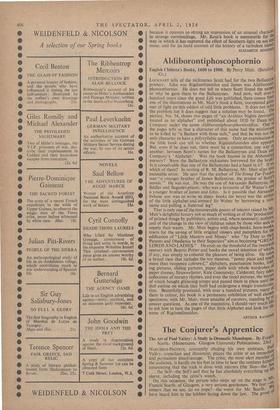Aldiborontiphoscophornio
English Children's Books, 1600 to 1900. By Percy Muir. (Botsford. 42s.) LOCKHART tells of the nicknames Scott had for the two BallantYll! printers. John was Rigdumfunnidos and James was Aldiborontr phoscophornio. He does not tell us where Scott found the merles or why he gave them to the Ballantynes. And now, well over a hundred years since the great Life was published, there comes frail' one of the illustrations in Mr. Muir's book a faint, unexpected 814114 mer of light on this oddest of odd little problems. It does not solve the problem but it does suggest that a solution may be found. 1116 picture, No. 54, shows two pages of "an Arabian Nights derivatil treated as an alphabet" and published about 1820 by Dean and Company under the name Aldiborontiphoseophorniostikos. One of the pages tells us that a character of this name had the misfortune to be killed by "a Bashaw with three tails," and that he was not the only character to have a polysyllabic name. Only an examination al the little book can tell us whether Rigdumfunnidos also appears' But, even if he does not, there must be a connection, one way or another, between Scott's names for the Ballantynes and Dean and , Company's 'Alphabet.' Was the book known in the Abbotsford nursery? Were the Ballantyne nicknames borrowed for the book' Is it conceivable that one of the Ballantynes had a hand in it? If 5°' which of them? In writing of R. M. BaHantyne, Mr. Muir slips into excusable error. He says that the author of The Young Fur-Trader! was "a younger brother of James Ballantyne, the printer of Scotts novels." He was not. He was the son of Alexander Ballantyne, the fiddler and flageolet-player, who was a favourite of Sir Walter's and a younger brother of James and John. Is it possible that Alexander t (whose son was to write so many books for boys) was the authT of the little alphabet and amused Sir Walter by borrowing a nick'' name and pulling a fraternal leg?
ARTHUR RANS-


















































 Previous page
Previous page